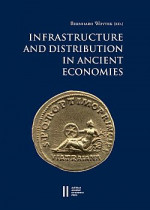WOYTEK Bernhard (Hg.) Infrastructure and Distribution in Ancient
WOYTEK Bernhard (Hg.) Infrastructure and Distribution in Ancient Economies
Proceedings of a conference held at the Austrian Academy of Sciences, 28-31 October 2014
Reihe: Denkschriften der philosophisch-historischen Klasse, Band: 506
Erscheinungsdatum: 07.03.2019, 534 Seiten, 29,7x21 cm, gebunden, Text englisch/französisch/deutsch.
In diesem Band wird der Ablauf der internationalen interdisziplinären Gründungskonferenz der Abteilung „Documenta Antiqua„ am Institut für Altertumsforschung der Österreichischen Akademie der Wissenschaften (Wien) aus dem Jahr 2014 vorgestellt. Forschungsschwerpunkt der neuen Abteilung sind die Quelldisziplinen der alten Geschichte: vor allem Epigraphik, Numismatik und Papyrologie. Das Buch ENTHÄLT einen einführenden Aufsatz sowie 17 Beiträge zu verschiedenen Aspekten der antiken Infrastruktur und zum Fluss von Geld, Waren und Dienstleistungen in antiken Volkswirtschaften: in der klassischen und hüllenistischen griechischen Welt, im Römischen Reich und im antiken Iran, aus dem Neo-Iran. Assyrische Zeit bis in die parthische und sasanische Zeit. Generell liegt ein besonderer Schwerpunkt auf numismatischen Beiträgen. Bisher spielte die Numismatik in der modernen Erforschung der antiken Infrastruktur kaum eine Rolle, obwohl Geld und Finanzdienstleistungen allgemein als wesentliche Elemente der Infrastruktur moderner Gesellschaften anerkannt werden. Damit ist die Numismatik in diesem Band erstmals vollständig in die Erforschung des Warenverkehrs und der Infrastruktur der Antike eingebunden. Unter den in diesen innovativen Beiträgen behandelten Themen sind die folgenden hervorzuheben: die wirtschaftlichen Auswirkungen der umfassenden Gegenmarkierung hüllenistischer Silbermünzen in Kleinasien; Einfuhr und Verwendung ausländischer und veralteter Bronzemünzen in Geldbeträgen; Muster der Münzproduktion und -verteilung im Römischen Reich im Fürstentum; Strukturen der Prägung im alten Iran in der Zeit der Arsakiden und Sasanen.
This volume presents the proceedings of the international interdisciplinary founding conference of the division „Documenta Antiqua” at the Institute für the Study of Ancient Culture of the Austrian Academy of Sciences (Vienna), held in 2014. The research focus of the new division are the source disciplines of ancient history: mainly epigraphy, numismatics and papyrology. The book contains an introductory essay as well as 17 contributions on various aspects of ancient infrastructure and on the flow of money, goods and services in ancient economies: in the classical and Hellenistic Greek world, the Roman Empire and in ancient Iran, from Neo-Assyrian times to the Parthian and Sasanian periods. In a general perspective, there is a special emphasis on numismatic contributions. So far, numismatics hardly played a part in modern research on the ancient infrastructure, although money and financial services are universally acknowledged to be indispensable elements of the infrastructure of modern societies. Hence, in this volume numismatics is fully integrated into research on the circulation of goods and the infrastructure of the ancient world für the very first time. Among the topics covered in these innovative contributions the following may be singled out: the economic implications of the extensive countermarking of Hellenistic silver coinages in Asia Minor; the importation and monetary use of blocks of foreign and obsolete bronze coins; patterns of coin production and coin distribution in the Roman Empire in the principate; structures of minting in ancient Iran in the Arsacid and Sasanian periods.
Dieser Band ENTHÄLT einen Einleitungsessay sowie 17 Beiträge zur Infrastruktur und dem Fluss von Waren, Geld und Dienstleistungen im antiken Griechenland, im Römischen Reich und im vorislamischen Iran. Publiziert werden die Akten des internationalen interdisziplinären Gründungskongresses der Abteilung „Documenta Antiqua„ am Institut für Kulturgeschichte der Antike der Österreichischen Akademie der Wissenschaften. In Übereinstimmung mit dem Forschungsprofil der Abteilung führen die Beiträge paradigmatisch vor Augen, welch fundamentalen Beitrag Epigraphik, Numismatik und Papyrologie ‒ im Zusammenwirken mit der Archäologie ‒ zur Erforschung der antiken Ökonomie leisten. Der Begriff „Infrastruktur„ wird heute
oft in einem weißen Sinne verwendet, und zwar nicht nur in Bezug auf bauliche Strukturen wie Straßen, Häfen, Wasserleitungen oder Kanäle, sondern auch in Bezug auf institutionelle Konzepte, z. B. das Bildungssystem oder das Rechtssystem eines Staates ‒ oder auch sein Geld- und Finanzsystem. Vor allem der letztgenannte Aspekt wurde bisher in der althistorischen Forschung allerdings nicht entsprechend berücksichtigt. In vorliegendem Kongressband wird deshalb erstmals die Numismatik in die Erforschung der antiken Infrastruktur miteinbezogen ‒ auf numismatischen Beiträgen liegt dementsprechend ein Schwerpunkt des Bandes. Es handelt sich um eine Sammlung spezialisierter Fallstudien, die die Forschung zu infrastrukturellen Aspekten verschiedener antiker Wirtschaftsräume in eine neue Richtung lenken kann.
This volume contains an introductory essay and 17 articles on the infrastructure and flow of goods, money and services in ancient Greece, the Roman Empire and pre-Islamic Iran. The files of the international interdisciplinary founding congress of the Documenta Antiqua" department at the Institute für Ancient Cultural History of the Austrian Academy of Sciences are published. In line with the research profile of the department, the contributions paradigmatically demonstrate the fundamental contribution that epigraphy, numismatics and papyrology - in cooperation with archeology - make to the study of ancient economics. The term "infrastructure" is used today
often used in a broad sense, and not only in relation to structural structures such as roads, ports, water pipes or canals, but also in relation to institutional concepts, e.g. B. the education system or the legal system of a state - or its monetary and financial system. Above all, the latter aspect has not been taken into account in ancient history research. This is why this volume of congresses is the first to include numismatics in the research of the ancient infrastructure - accordingly, the volume focuses on numismatic articles. It is a collection of specialized case studies that can take research on the infrastructural aspects of various ancient economic areas in a new direction.
Quelle: Verlagsinfo 

